NORFOLK, Va. — Your smartphone is probably in your hand right now. You’re likely even using it to read this article. It holds all our information, allows us unlimited searches and watch events unfold live — but that wasn't always the case.
During WTKR’s 75-year history, the technological changes have been significant.
Inside the state-of-the-art facility in downtown Norfolk on Boush Street was a newsroom and dedicated TV studio, outfitted with hot, incandescent lighting and large, heavy film cameras.
"These processes were huge, you would think you had a landing pad for an airplane, but this processor you would process and process and it would take like two hours in the afternoon. The film has to be in here no later than 2 p.m. because by the time we get it through - the time we get it washed, rinsed, and dried and edited, we're going to be lucky to get it on the 6 p.m. or 5:30 p.m. news,'" a former employee recalled.
A few years later came the change from Channel 4 to 3. The evolving broadcast landscape hit a new dimension in the late 1960s, bringing color TV to living rooms across Tidewater.
"WTKR was always big into experimenting to see what the boundaries were," said Sperry Davis, former Director of Engineering for the Digital Operating Center at WTKR.
Davis worked at what would become WTKR Channel 3 for 45 years as the Director of Engineering for the Digital Operating Center. The “DOC,” designed by Davis, is the main control center that keeps multiple Scripps stations across the country running smoothly and on schedule — all from our building.
“[This was a huge benefit for stations,] as even the larger station markets freed up some of their operators. So, stations like Moline, Illinois and Des Moines could actually allow the staff to go home at night, and the station would stay on the air because it was being controlled from Norfolk here,” Davis said.
When he was first hired, he recalled mechanical typewriters in the newsroom and no portable cameras, other than film cameras.
"Some of the gear that was here when I started was original from the 1950s so needed to be upgraded," Davis said.
Like the graphics system, which Davis remembers was once done by hand by a graphic artist.
"They would create art cards and put them up on a stand and a camera would shoot them, and that's the only way to get any kind of titling or graphics at all," Davis said.
He said, at the station “live trucks” didn't exist in 1977. But along the way, thanks to the station's engineers, the fleet grew.
"They were built by station staff for the most part," Davis said.
Station engineers would buy a van and build the equipment themselves.
"Yes, we'd buy a van, and we'd buy a mast, a telescoping pneumatic mast, and cut a hole in the top of the van," Davis said.
Over the years, the size and weight of cameras have also evolved. As Morgan Evans, another former employee, told anchor Kurt Williams, the old cameras were much heavier to carry on remote assignments.
Davis agreed, "you went from these monster cameras with the big lids on them. It would be, you know, 18-20 inches and like an eight-inch rectangle to the small cameras that we're using now.”
Small cameras with big impact and capability. Not to mention artificial intelligence, mobile live streaming and digital storage and editing.
With new tech came more broadcasts at WTKR and the expansion of our sister station WGNT. The old studios were replaced with new lighting, new cameras, and AI-operated systems — a move towards efficiency and non-stop local news.
"I'm proud to have been part of it for 45 years and [I hope] to see that it continues," Davis said.
News 3 is evolving every day, trying to be more efficient, and adapting to how you — our viewers — consume content, whether you're commuting across the HRBT, at home in Norfolk or checking in from Virginia Beach.
This story was reported on-air by a journalist and has been converted to this platform with the assistance of AI. Our editorial team verifies all reporting on all platforms for fairness and accuracy.





